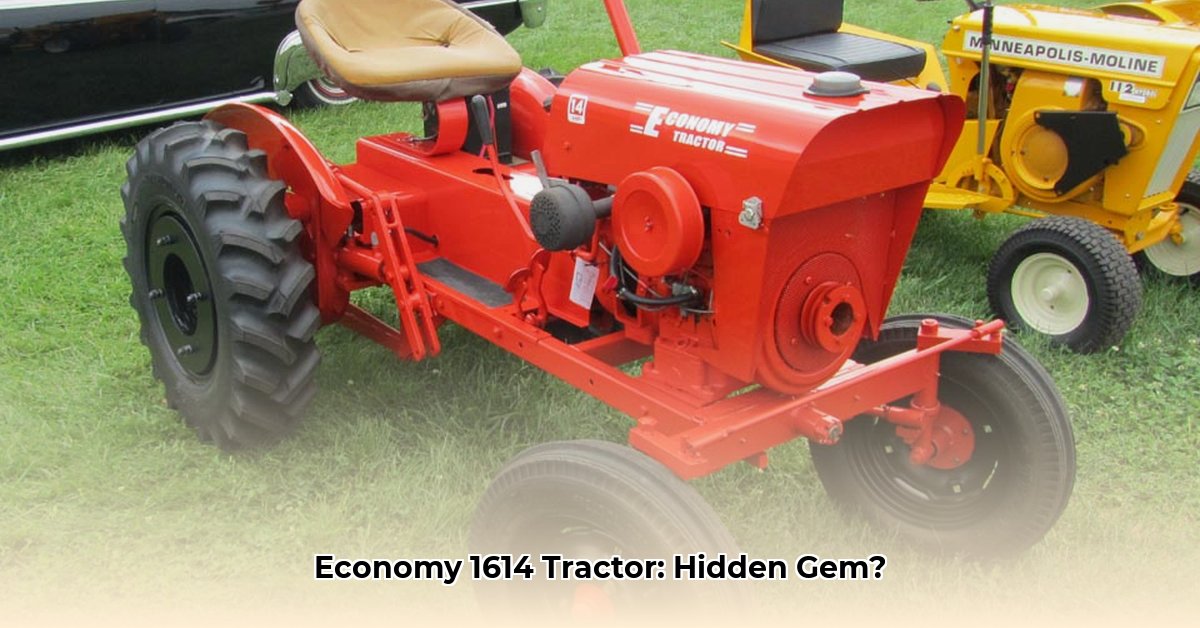
The Economy 1614 tractor, a product of the Engineering Products Company (EPCO), represents a fascinating chapter in mid-20th-century agricultural technology. This article delves into its history, performance, and key differences when compared to its sibling model, the Power King 1614. We'll explore the features that made these tractors workhorses of their time, analyzing their design, functionality and place within the broader context of agricultural mechanization. For more on vintage tractors, check out this helpful resource: 1950s Tractors.
Understanding the Economy 1614 and Power King 1614 Tractors
Both the Economy 1614 and Power King 1614 tractors share a common ancestor – the reliable Kohler 14-horsepower, 512cc single-cylinder gasoline engine. This robust engine formed the backbone of their functionality, proving suitable for a multitude of farm tasks. However, a closer examination reveals subtle yet significant variations in their design and capabilities. Why did EPCO offer these nearly identical models with differing specifications? The answer likely lies in catering to diverse farmer needs and budgetary considerations.
Engine and Powertrain: A Shared Foundation, Divergent Paths
While both models utilized the same powerful Kohler engine, their transmission options differed considerably. The Power King 1614 offered a range of transmissions: 3-speed, 4-speed, and even a 9-speed option. This flexibility offered farmers greater control and versatility. The Economy 1614, in contrast, presented only 3-speed and 9-speed choices. The differing transmission options highlight a key differentiation strategy; the Power King targeting farmers seeking enhanced operational flexibility, while the Economy 1614 prioritized value and simplicity. Beyond transmission, the final drive systems distinguished the two models: Power King utilized bull gears, and Economy 1614 employed spur bull gears, each impacting efficiency and overall performance.
Braking, Hydraulics, and PTO Systems: Tailored to the Task
The braking systems also showcased distinctions. The Power King employed mechanical drum brakes, while the Economy 1614 utilized mechanical band brakes. These variances, though seemingly minor, directly impacted maintenance and operational characteristics. Furthermore, the hydraulic systems varied. The Power King featured a 1.7 gallons-per-minute (gpm) pump, while the Economy 1614 provided a slightly more robust 1.8 gpm pump, with a heavy-duty 7.5 gpm option available. This heavier-duty variant likely positioned the Economy 1614 to tackle demanding tasks, hinting at its adaptability— a clear advantage for farmers prioritizing strength and power. The Power Take-Off (PTO) systems further illustrate this divergence. The Power King incorporated separate front and rear PTOs with electromagnetic clutches—allowing for precise control over connected implements such as mowers or balers. The Economy 1614, however, relied on a single continuous front PTO, favoring simplicity over the enhanced precision of its sibling model.
Comparative Analysis: A Side-by-Side Look
The following table directly compares the key features of the Economy 1614 and Power King 1614 tractors:
| Feature | Power King 1614 | Economy 1614 Tractor | Key Differences |
|---|---|---|---|
| Engine | Kohler 14HP, 512cc, single-cylinder | Kohler 14HP, 512cc, single-cylinder | Identical; a reliable engine for its time. |
| Transmission | 3-speed, 4-speed, 9-speed | 3-speed, 9-speed | Power King offered greater versatility. |
| Final Drive | Bull Gear | Spur Bull Gear | Varied gear designs impacting efficiency. |
| Brakes | Mechanical Drum | Mechanical Band | Different braking mechanisms. |
| Hydraulic Pump | 1.7 gpm | 1.8 gpm, 7.5 gpm (heavy-duty option) | Economy 1614 offered a higher-output option. |
| PTO | Independent Front & Rear, EM Clutches | Continuous Front PTO | Power King offered greater PTO control. |
| Mower Deck Sizes | 48", 60" | 36", 48", 60" | Range of sizes available for both models. |
Restoring a Vintage Power King 1614 Tractor's PTO System: A Detailed Guide
Restoring a vintage Power King 1614's PTO system presents a unique challenge. Unlike simpler designs, the Power King employs an electromagnetic clutch, adding complexity to the restoration process. The following steps outline a systematic approach to this demanding task.
Restoring the Power King 1614 PTO: A Step-by-Step Approach
- Disassembly: Carefully dismantle the PTO shaft and associated components, taking detailed photographs and labeling wires to facilitate reassembly.
- Inspection: Meticulously clean each component, assessing wear and tear. Identify any damaged or broken parts requiring replacement.
- Repair/Replacement: Repair or replace parts as necessary, paying close attention to the critical electromagnetic clutch. Expert assistance may be advisable for this complex component.
- Reassembly: Using your photographic documentation, meticulously reconnect all components, ensuring accurate wiring to prevent short circuits.
- Testing: Before reinstallation, thoroughly test the PTO’s functionality to confirm its proper operation.
Addressing Common Challenges
Even after careful restoration, problems can persist. If the PTO fails to engage, systematically examine the power supply, wiring integrity, and the electromagnetic clutch itself. Online forums and specialized repair manuals can offer invaluable assistance in troubleshooting these issues. This detailed restoration process is crucial for maintaining the historical and functional integrity of this important piece of agricultural machinery.
This article provides a comprehensive overview of the Economy 1614 and Power King 1614 tractors, highlighting their key features, differences, and restoration considerations.